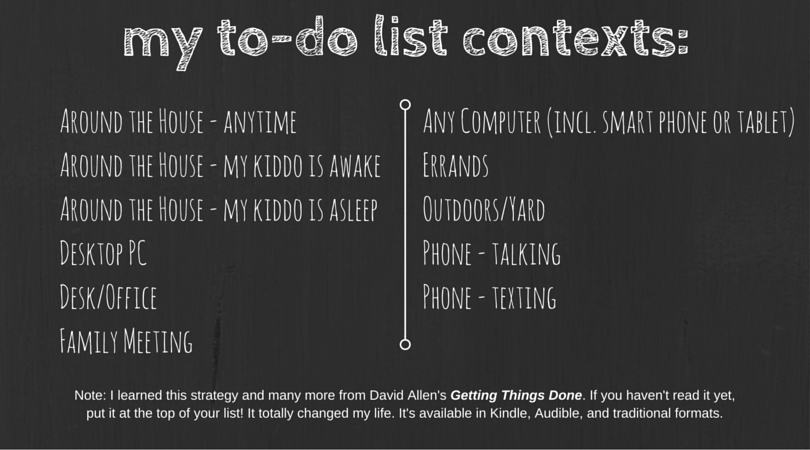I hate knowing I have tons to do, yet blanking when I try to think of specific tasks. This feeling defined my mid-20s, just before I started learning about and treating my ADHD.
I existed in a constant state of stress and anxiety, but I couldn’t articulate — even to myself — what exactly I needed to do.
Medication helped settle my thoughts. Next, I needed a system to organize them.
My salvation came in the form of David Allen’s Getting Things Done. If you haven’t tried GTD or if you find the whole system too rigid, allow me to share one of the most important concepts:
Context is everything.
Why traditional lists and planners failed me
To-do lists never worked for me until I sorted them by context — that is, the location or resources they require. This was a major paradigm shift. I spent years struggling with calendar-based personal planners and daily to-do lists, recopying incomplete tasks from one day to the next.
Of course, some tasks need to happen on a specific day, like paying rent or turning in kids’ summer camp registrations. I still write those on my calendar. Others just require the right environment: a phone, a quiet room, a computer, or a specific person. For those, I keep context-based to-do lists in an app called Toodledo. Toodledo’s web and mobile apps keep my lists at my fingertips everywhere I go. Here are my contexts:

I also generate contexts as needed for my mom, husband, grandmother, and anyone else I converse with regularly.
If you dislike apps, try a sheet of loose leaf paper or a page in a notebook for each context. Anything that keeps your lists separate will do just fine.
Still wondering how this beats one neat, centralized list?
Allen claims, and I agree, that a single list would make it “too difficult to see what you need to see; each time you got any window of time to do something, you’d have to do unproductive re-sorting.”
Consider this alongside ADHD’s inherent working memory weaknesses. As Russell Barkley explains in Taking Charge of Adult ADHD, we use working memory to organize and prioritize tasks, hold multiple things in mind, and figure out what to do next.
For someone with unreliable working memory, a poorly-organized to-do list isn’t just “unproductive,” it’s paralyzing.
 “It’s not that you’re incapable of logical analysis or you lack intelligence…” Barkley writes, “it’s just that you need to make the process tangible and external…so your emotions don’t erupt with the frustration of trying to do it all in your head.”
“It’s not that you’re incapable of logical analysis or you lack intelligence…” Barkley writes, “it’s just that you need to make the process tangible and external…so your emotions don’t erupt with the frustration of trying to do it all in your head.”
Externalizing tasks into contextual ‘buckets’ takes a huge load off your working memory. This makes it easier to get into your productivity groove (sometimes known as hyperfocus).
Hyperfocus for good
Hyperfocus has a bad reputation in our household. It makes it hard for ADHD’ers to change gears and switch tasks. However, with context-based to-do lists, we can use hyperfocus to our advantage.
I may put phone calls off as long as possible, but by the time I force myself to do it (usually a deadline is looming), I settle in and finish them all at once. My husband calls this “task inertia.”
Here’s the thing: I’d freak out if I tried to comb through my to-do list (usually 60+ items long) for the three phone calls I need to make. A separate, ready-to-roll, phone-calls-only list enables me to make more than one of the dreaded calls. It removes obstacles to task inertia.
Reclaiming lost time
In Getting Things Done, Allen stresses the importance of capturing “weird little windows” of time. Most of us use 10 minutes in a waiting room to cruise our smart phone. What if you check two small items off your to-do list instead? My “any computer” (a definition that includes my phone) list contains tasks like “make dinner reservations” (easy with the OpenTable app), “look at calendar for game night dates,” and “use quilt tutorial to make a list for the fabric store.”
These are the baby steps that move me from Point A to Point B, from “we should get together soon” to “see you on Friday night for dinner and board games.” They’re also the details that can slip through my fingers and make me feel like a major flake. ADHD doesn’t change society’s expectations, but it sure makes it tough to keep up.
Experience has taught me, when I receive one of those “weird little windows,” I need to be ready. I need to know what one tiny thing I can get done with the resources at hand. Organizing my to-do list by context has been the key to making that happen — and to tricking people into thinking I have it together.
How do you organize your to-do list? Does it work for you? Please share in the comments!
Hey there! Are you enjoying The ADHD Homestead?
Here's the thing: I don't like ads. I don't want to sell your attention to an advertising service run by the world's biggest data mining company. I also value my integrity and my readers' trust above all, which means I accept very few sponsorships/partnerships.
So I'm asking for your support directly. For the cost of one cup of coffee, you can help keep this site unbiased and ad-free.
Below you will find two buttons. The first lets you join our crew of Patreon pals and pledge monthly support for my work. Patrons also have access to my Audioblogs podcast. The second takes you to a simple donation page to pledge one-time or recurring support for The ADHD Homestead, no frills, no strings. Do whichever feels best for you!

